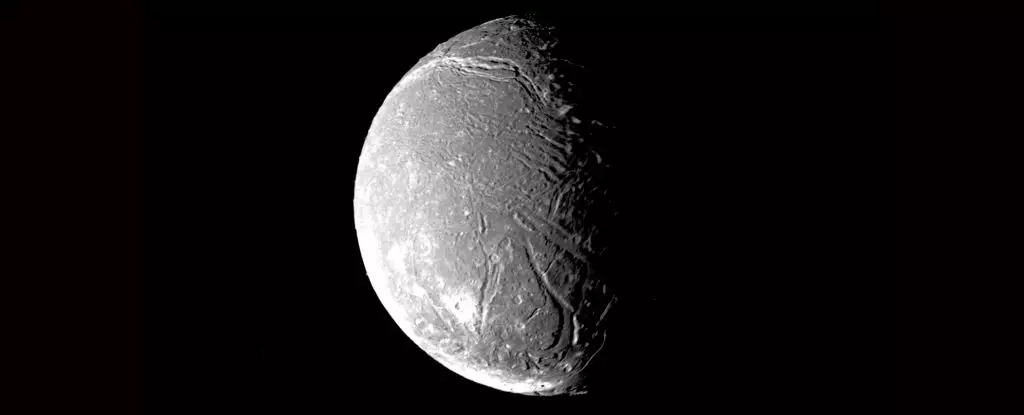The exploration of our Solar System often uncovers fascinating enigmas, particularly when it comes to the moons orbiting the gas giants. Among these celestial bodies, Ariel, one of Uranus’s intriguing moons, offers a glimpse into a world that may harbor secrets beneath its icy surface. With the potential of liquid oceans lying hidden below thick layers of ice and rock, understanding Ariel may unlock crucial information about not only its own geological history but also the broader context of ocean worlds in our cosmic neighborhood.
Ariel’s surface is marked by striking geological formations, including deep chasms that crisscross the landscape. These features are not mere cracks; they may signify a deeper connection to the moon’s interior. Planetary geologists like Chloe Beddingfield from Johns Hopkins University Applied Physics Laboratory suggest that these chasms could serve as pathways for materials expelled from the depths of Ariel. The presence of carbon dioxide ice and other carbon-bearing deposits in these grooves hints at complex chemical processes that might be occurring inside this frigid moon.
This geological activity is especially captivating because the presence and nature of these surface interruptions speak volumes about what could be going on beneath Ariel’s ice-covered crust. The patterns seen in the chasms, including their parallel grooves, indicate that Ariel’s geological history is dynamic, possibly driven by tectonic and volcanic activity.
Researchers have drawn intriguing parallels between processes occurring on Earth and the geological features on Ariel. One potential mechanism they consider is known as “spreading,” which happens at tectonic plate boundaries on our planet. This process involves the movement of warm material from below that causes the surface to crack and shift, leading to the formation of new geological structures.
In Ariel’s case, if similar dynamics are at play, the chasms might result from warmer materials pushing upward, creating rifts in the icy mantle. This geological theory not only explains the features observed but hints at a potentially vibrant internal ecosystem that could keep the subsurface ocean in a liquid state. The evidence that Beddingfield and her colleagues found, such as matching edges of the chasms and the orderly layers of material deposited over time, supports this idea of an active geology.
Another crucial aspect of Ariel’s geophysical characteristics roots itself in the concept of orbital resonance. Uranus’s moons, in particular, have a history of entering orbital lockstep, resulting in gravitational interactions that create a “tug-of-war” effect. Such dynamics can lead to internal heating, which is crucial for maintaining the liquid state of potential subsurface oceans.
If Ariel has indeed experienced periods of resonance with its neighboring moons, such interactions could have spurred geological changes, contributing to the features seen on its surface today. Observations from the James Webb Space Telescope (JWST) provide tantalizing hints that a liquid ocean may be lurking below Ariel’s icy exterior, reinforcing the notion that Ariel is more than just another frozen moon – it is a candidate for an ocean world, ripe for exploration.
Despite the tantalizing clues that Ariel may present, significant gaps remain in our understanding. The presence of carbon oxide ices on the surface opens questions about their relationship with the features we see, yet past missions like Voyager 2 were not equipped to provide detailed mapping of these deposits. As such, the scientific community finds itself at a crossroads; there is a compelling need for a dedicated exploration mission to UFOs and Neptune.
Not only will such missions expand our knowledge of Ariel, but they will also deepen our understanding of ocean worlds throughout the Solar System. These icy moons may hold key insights into the origins of life, geophysical processes, and planetary formation itself. Therefore, as a collective, we should champion the pursuit of these missions, urging space agencies to prioritize these mesmerizing worlds.
The mysteries contained within Ariel’s icy chasms and the possibility of a hidden ocean beneath its surface amplify the excitement surrounding planetary research. As we probe into the cosmic sea of knowledge, Ariel could be a critical piece in understanding the dynamics of our Solar System and the potential for life beyond Earth. The scientific community must act decisively to advocate for exploration, for every piece of information gleaned about Ariel and its hidden depths may resonate far beyond its distant orbit around Uranus. Time is of the essence for ambitious space missions – the search for knowledge beckons.


Leave a Reply